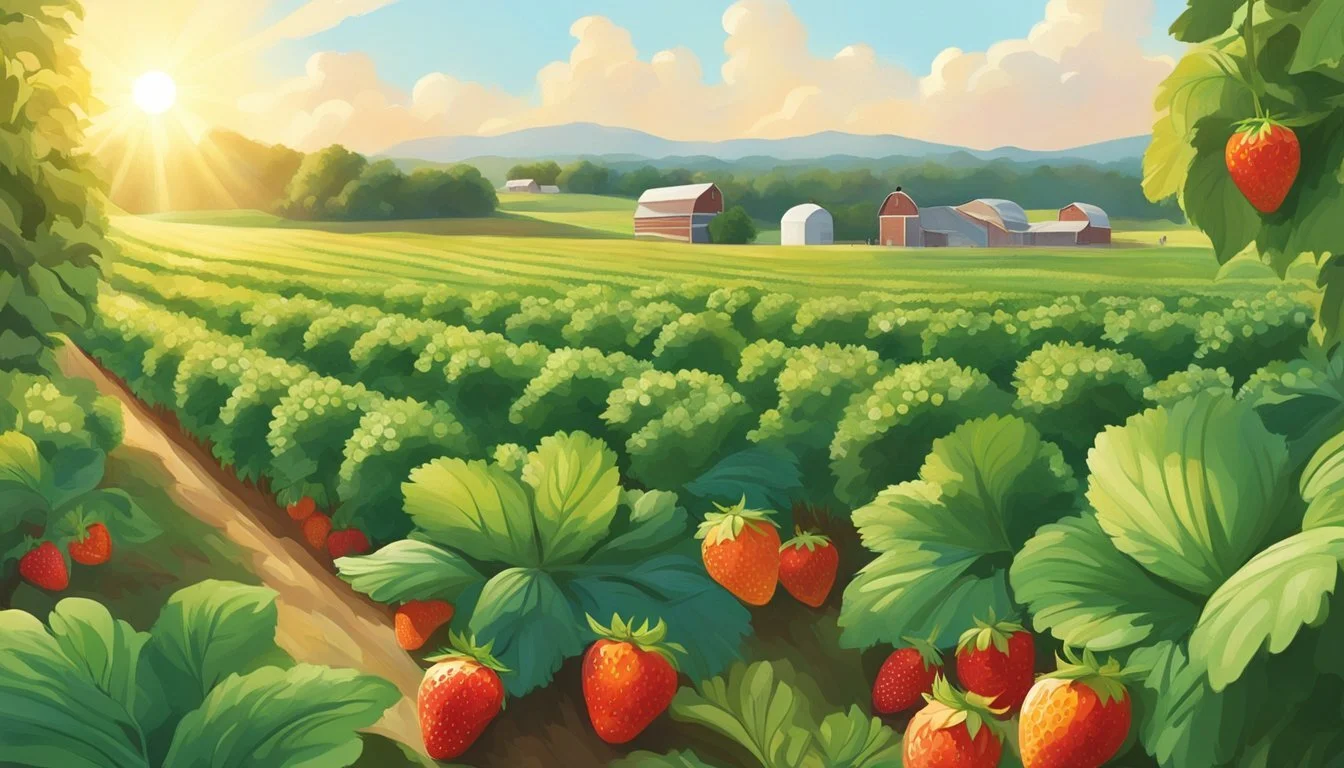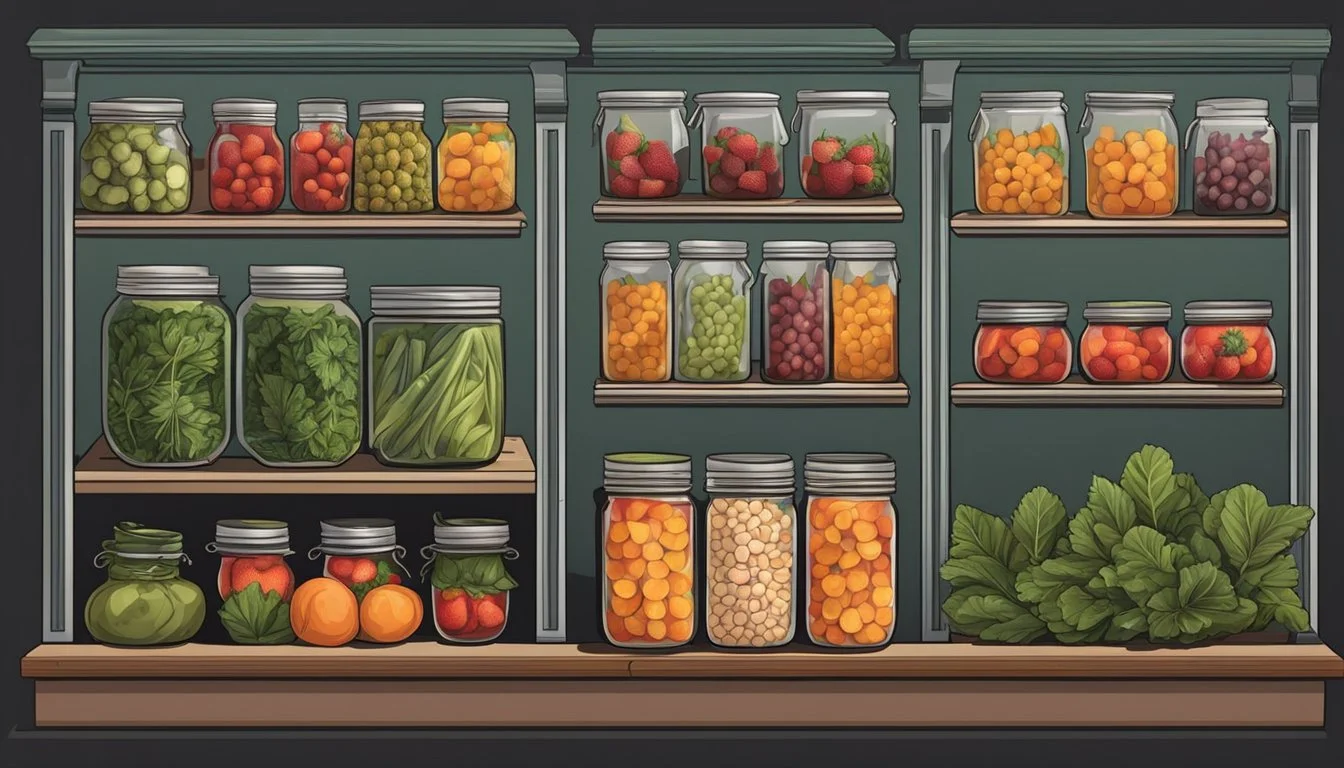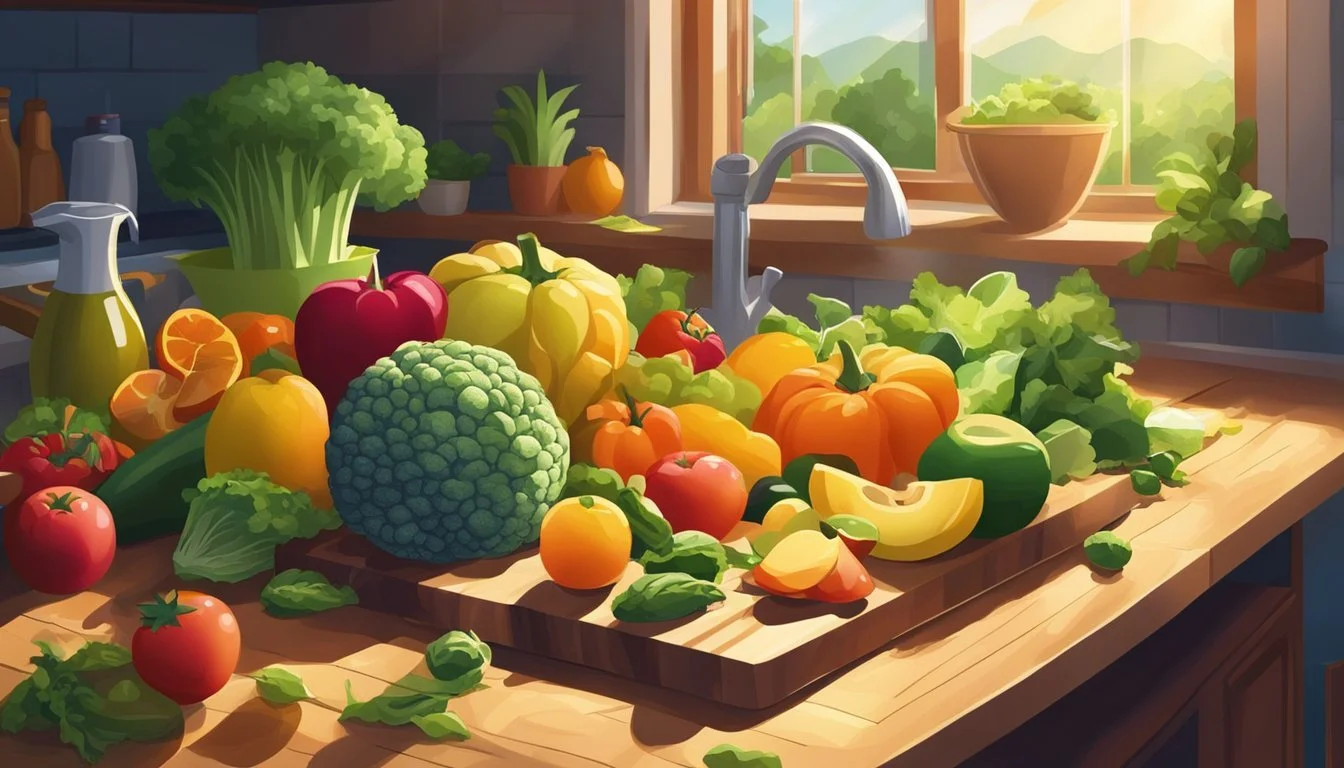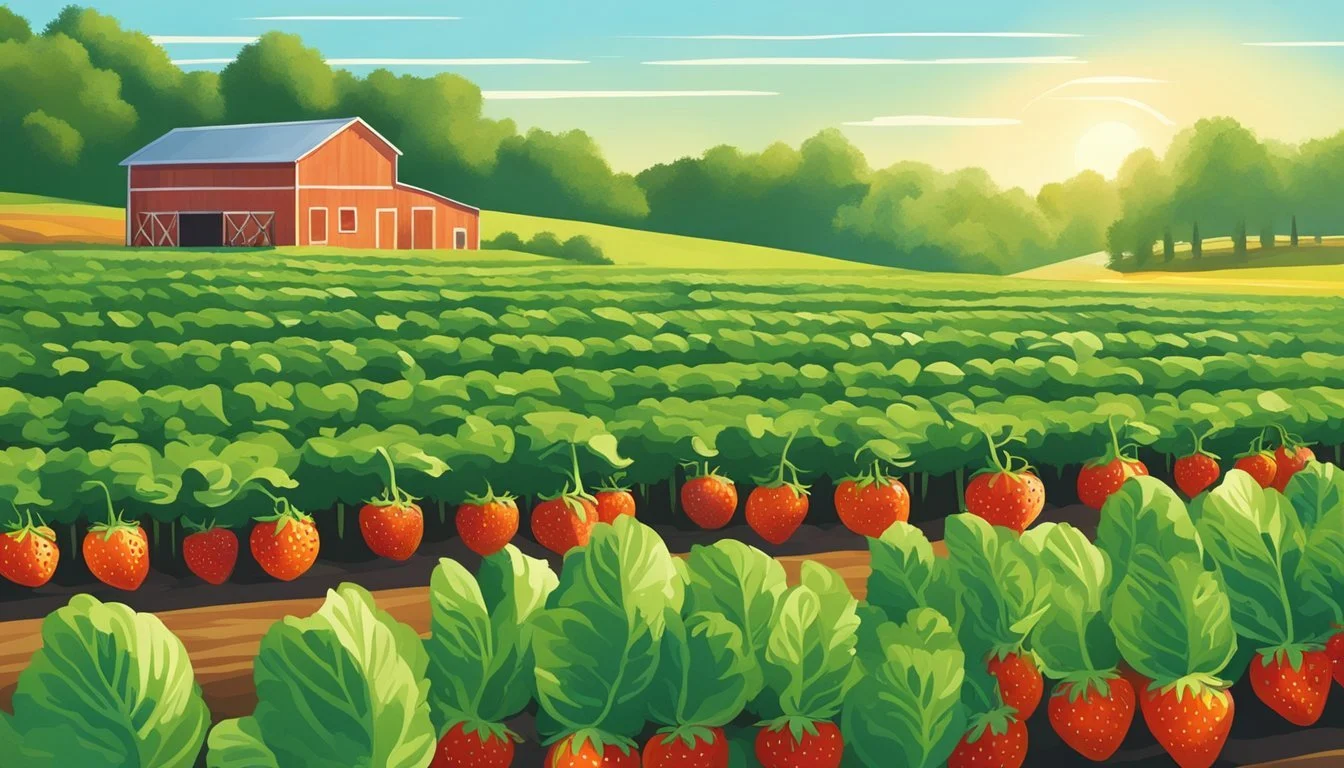South Carolina Seasonal Fruit & Vegetables in March
Your Fresh Guide
This Article is Part of our South Carolina Seasonal Fruit & Veg Calendar
South Carolina boasts a rich tapestry of agricultural products, and March is an opportune time to explore the range of seasonal fruits and vegetables available. During this period, the state's temperate climate and fertile soil yield an abundant harvest that promises freshness and flavor. For those who are enthusiastic about farm-to-table eating or simply seeking the freshest produce, this month offers a variety of options.
Among the fruits and vegetables that come into season in March are the cruciferous vegetables, such as broccoli and cauliflower, which are known for their health benefits and versatility in the kitchen. Root vegetables like carrots and beets continue to thrive, offering earthy flavors (What wine goes well with earthy flavors?) and a burst of color to any dish. Leafy greens, including kale and collard greens (how long do collard greens last?), remain in prime condition, providing both traditional Southern dishes and innovative culinary creations with nutritious greens.
As the spring season approaches, South Carolina's produce selection begins to transition, welcoming the early stirrings of new growth while still delivering the last of the cool-season crops. This makes March an exciting time for consumers and chefs alike to enjoy the seasonal bounty that South Carolina’s farms have to offer.
Understanding South Carolina's Growing Seasons
South Carolina's climate is conducive to year-round agriculture, with distinct growing seasons that accommodate a wide variety of fruits and vegetables. Spring in South Carolina marks the onset of warmer temperatures, which introduces a period suitable for the production of an array of produce starting as early as March.
Summer brings heat and humidity, which are favorable conditions for many crops, but it also demands that farmers pay close attention to irrigation to combat potential dry spells.
Fall sees a gradual cooldown, offering a new set of growing conditions ideal for different types of produce that prefer cooler temperatures. Finally, winter in South Carolina, while cooler, still sustains certain hardy crops due to the region's milder winters compared to more northern states.
Spring: Asparagus, Basil
Summer: Tomatoes, Peaches
Fall: Apples, Greens
Winter: Root vegetables, Leafy greens
During the spring months, farmers are planting and beginning to harvest crops like asparagus and leafy greens. They are planning for the succession of produce that will go through the summer months and into fall.
One must also consider the state's varying landscapes, from coastal plains to upland terrains, which can influence local growing conditions and, consequently, the availability of specific produce in different regions.
Farmers adeptly navigate these seasonal shifts, ensuring a fresh selection of produce for consumers through differing times of the year. Their expertise in working with the land’s natural rhythms is essential to support a sustainable, year-round bounty.
March's Seasonal Produce Highlights
March in South Carolina marks a transitional period in local agriculture, with a variety of both winter and spring produce available. Farmers' markets and grocery stores are brimming with fresh, flavorful selections that reflect the region's agricultural diversity.
Vegetables:
Broccoli: Vibrant and firm heads of broccoli are abundant during this time. Noted for their earthy flavor, they are most tender and less bitter when harvested in cooler temperatures.
Brussels Sprouts (how long do brussels sprouts last?): These are at the end of their season yet still offer a nutty and sweet taste when roasted.
Cabbage: Cabbage varieties offer crisp textures and range from sweet to peppery in flavor.
Spinach (What wine goes well with spinach?): These tender greens, with their subtly sweet flavor, are perfect for salads and are readily available.
Kale: Kale is hearty and offers a slightly bitter taste, but it becomes sweeter after frost.
Fruits:
Citrus fruits, though not primarily grown in South Carolina, may still be found in local markets. These imported fruits include:
Oranges: Juicy and sweet, high in vitamin C.
Lemons: Bright acidity, perfect for adding a zesty flavor to dishes.
Availability and Harvest Notes:
Cruciferous vegetables like broccoli and Brussels sprouts thrive in the cool weather of early spring. These crops are often harvested at peak flavor before the heat sets in.
Leafy greens, such as spinach and kale, continue to thrive in March, their flavors intensifying before the rising spring temperatures.
Bold flavors and fresh produce characterize South Carolina's March offerings. From the hearty crunch of Brussels sprouts to the zesty tang of citrus, consumers can enjoy a rich tapestry of taste and nutrition from the local harvest.
Fruits Available in March
In March, South Carolina's fruit offerings are varied, with citrus fruits reaching the end of their season and berries beginning to make an appearance.
Citrus Fruits
March in South Carolina is notably the tail end of the citrus season. Consumers can find a variety of oranges that are still available, with their juicy segments offering a refreshing tang.
Navel Oranges: Easy to peel, they are ideal for eating fresh.
Valencia Oranges: Typically juicier, excellent for making fresh orange juice.
Berries & Exotics
As winter wanes, early varieties of strawberries and blackberries (how long do blackberries last?) start to appear. They are enjoyed for their tart yet sweet flavor profile.
Strawberries: Begin to ripen, and can be found at local markets, hinting at the full bounty that spring will bring.
Blackberries: While not yet at their peak, early season blackberries may be available from growers who use protective coverings to extend their season.
Vegetables to Enjoy in March
March marks a transitional period in South Carolina, where the blend of cool and warming weather allows for a variety of vegetables to thrive. Vegetable enthusiasts can anticipate the arrival of crisp leafy greens, a diverse range of hearty root vegetables, and nutrient-rich cruciferous vegetables.
Leafy Greens
Leafy greens are at their best during cooler weather, which makes March an ideal time for them. Shoppers may find a selection of:
Kale: Known for its robust flavor and nutritional benefits.
Spinach: Offers versatility for both raw and cooked dishes.
Collard Greens: A Southern staple, best enjoyed cooked to tenderness.
Arugula: Adds a peppery note to salads and sandwiches.
Lettuce: Varieties like romaine and butterhead are garden-fresh options.
Root Vegetables
Root vegetables harvested in March offer earthy flavors and are perfect for roasting or incorporating into stews. Notable mentions include:
Carrots: Sweet and crunchy, suitable for both raw snacking and various recipes.
Beets: Deeply colored with a sweet, earthy taste, beets are excellent for salads and side dishes.
Radishes: With a sharp bite, these are a great addition to salads.
Turnips: Can be enjoyed both raw and cooked, having a slightly peppery flavor.
Cruciferous Vegetables
Cruciferous vegetables are well-regarded for their health benefits and are abundant in March. Look for the following:
Broccoli: A versatile vegetable that can be eaten raw or cooked.
Cauliflower: Popular for its adaptability in recipes like cauliflower rice or roasted florets.
Cabbage: Essential for slaws or slow-cooked dishes.
Brussels Sprouts: Small in size but big on flavor, best when roasted until crispy.
Purchasing and Storing Tips
When purchasing seasonal fruits and vegetables in South Carolina during March, consumers should select items based on their characteristic color, shape, and size, which are indicators of good taste and texture. It's important to note that produce doesn't have to look perfect to be of high quality; often, the best flavors come from slightly imperfect fruits and vegetables.
Purchasing Tips:
Seasonal Availability: Shoppers should seek out March favorites like strawberries and leafy greens, as they are in peak season and abundant in South Carolina markets.
Flavor: For the finest flavor, one should buy produce that's been harvested at its peak. Local farmers' markets are ideal venues for finding the freshest options.
State Markets: Consumers are encouraged to support local farms as items sourced from nearby retain more nutrients and support the state's agricultural economy.
Storing Tips:
Refrigeration: To extend freshness, leafy greens should be stored in the refrigerator immediately after purchase. Root vegetables, however, can be stored in a cool, dark place for up to two weeks.
Preparation: All fruits and vegetables should be washed under running water before consumption. After cutting or peeling, they should be refrigerated as soon as possible.
Storage Method Items Duration Refrigerate Strawberries, Greens Use within 5-7 days Cool, Dark Place Root Vegetables 2+ weeks
By following these tips, consumers can enjoy the full flavor spectrum that South Carolina's seasonal produce has to offer while minimizing food waste through proper storage techniques.
Preparing Seasonal Dishes
In South Carolina, March brings a delightful array of fruits and vegetables that can be transformed into fresh, flavorful dishes. Seasonal greens such as kale and spinach thrive during this time and are ideal for nutritious salads, sautés, and smoothies. Chefs and home cooks alike utilize these vibrant greens to add color and a nutritional boost to their spring menus.
When developing recipes, one might consider the subtle sweetness of in-season artichokes (What wine goes well with artichokes?); they can be steamed, grilled, or stuffed to create satisfying main courses or appetizers. Emphasizing their natural flavor can be a simple yet effective way to enhance a dish.
Seasonal Produce:
Artichokes
Spinach
Kale
Recipe Ideas:
Artichoke hearts: grilled, steamed
Spinach: salads, quiches
Kale: chips, sautés
One should not overlook the versatility of herbs like basil, which begins its season in May. Although not yet available in March, anticipating its arrival can inspire ideas for future pesto-based recipes or herb-infused dishes.
When seeking to maximize the flavor of dishes, cooks will find it beneficial to use minimal seasoning, allowing the natural taste of the produce to stand out. They often pair these seasonal ingredients with proteins or grains to create balanced, delicious meals that reflect the produce peak in South Carolina’s March offerings.
Benefits of Eating Seasonally
Eating seasonally offers numerous benefits, particularly when it comes to the consumption of fruits and vegetables in South Carolina during March. It enhances flavor, as produce in season tends to be fresher, sweeter, and perfectly ripe. In South Carolina, March sees vegetables like broccoli and leafy greens thriving, which are typically more flavorful when harvested at the peak of their season.
In terms of health, seasonal fruits and vegetables may offer more nutrients. They are often harvested at their nutritional peak, which can provide a higher concentration of vitamins, minerals, and antioxidants. A seasonal eating pattern promotes a diverse diet throughout the year, as individuals consume a variety of produce that is naturally available, supporting a more well-rounded intake of nutrients.
Seasonal availability increases the likelihood of sourcing local produce, which supports the local economy and minimizes transportation time. This not only contributes to the environmental well-being by reducing the carbon footprint but also means that the consumer is getting produce that hasn't lost its nutritional value due to lengthy transport times.
Flavor: Harvested at its peak, providing a fresher and richer taste.
Health: High in nutrients when picked in the correct season.
Availability: Supports local farmers and reduces environmental impact.
Consumers benefit from the economic advantage as well, because fruits and vegetables in season are often more abundant and therefore less expensive. This seasonal abundance results in a cost-effective way for consumers to enjoy high-quality produce. Eating seasonally aligns well with a lifestyle that values health, community support, and environmental sustainability.
South Carolina's Food Festivals and Events
March heralds the beginning of spring and a rich tapestry of food festivals in South Carolina. The state's calendar brims with events celebrating South Carolina's agricultural bounty, showcasing a blend of community spirit and cultural heritage.
Strawberry Festivals:
Although the prime season for strawberries in South Carolina starts in April, preparations for strawberry festivals take off in March. These festivals are community gatherings where visitors can enjoy strawberry goods and look forward to events like the South Carolina Strawberry Festival in Fort Mill come May.
Local Food Fests:
South Carolinians take pride in their diverse food festivals which celebrate various aspects of their local delicacies. From seafood to barbecue, each event reflects the state's rich flavors, often combined with activities that foster community engagement and celebrate regional culture.
Irmo Okra Strut: In the town of Irmo, this unique festival gives okra the center stage, cooking it in every form imaginable. It is a reflection of South Carolina’s innovative spirit in the culinary arts.
Bluffton Boiled Peanut Festival: Boiled peanuts are declared the official state snack of South Carolina. Bluffton's boiled peanut celebration is a quirky event that pays homage to this beloved Southern treat.
While March might not be the peak month for South Carolina's produce, it sets the stage for the coming abundance of fruits and vegetables. It's a time when the community and visitors alike anticipate the array of flavors and experiences that will bloom with the warmer weather.
Future Outlook on Crop Availability
In South Carolina, March signifies a transitional period for crop availability as the state moves from winter into spring. The climate, characterized by a mild winter transitioning to a warmer spring, plays a significant role in determining the availability of various crops. SC farmers anticipate the upcoming harvest with optimism, relying on the state's historical data to predict the crop yield.
Key Crops and Expected Availability:
Strawberries: These are emerging in fields, with increased availability expected as the month progresses.
Greens: Including kale and cabbage, are reaching the end of their optimal harvest season.
Climate Impact: The weather influences crop conditions significantly, and any deviations from the norm can affect yield projections. South Carolina's climate, however, is generally conducive to a reliable harvest, barring unforeseen weather events.
Year-to-Year Variability: Seasonal fluctuations can lead to variations in crop production; however, South Carolina's agricultural sector is adept at adapting to these changes. Familiarity with the state's farming patterns allows for a degree of predictability in crop availability from year to year.
Broader State Perspective: South Carolina's state support structures, such as the Clemson Extension and the SC Department of Agriculture, continually monitor crop progress and provide resources for farmers. This synergy helps maintain steady crop availability and supports the local agricultural economy in the face of environmental and market fluctuations.
Resources and Guides
For those interested in South Carolina’s seasonal produce, various resources offer insight into what fruits and vegetables are available throughout the year, with specific guides for March. Consumers can find these products at local markets and through state-supported programs.
Local Harvest Calendars: Residents and visitors can utilize online harvest calendars for the most accurate, month-by-month breakdown of available produce. These guides list when specific fruits and vegetables are at their peak in South Carolina.
State Agricultural Website: The South Carolina Department of Agriculture provides resources detailing seasonal availability. The state promotes local agriculture through the "Certified SC" program, helping consumers identify and choose products grown in South Carolina.
Farmers' Markets: Farmers' markets across the state serve as a direct source for fresh, seasonal produce. They offer an array of vegetables like beets, carrots, and leafy greens during March. Market websites and social media pages often post updates on current offerings.
Maps and Apps: Interactive maps and mobile applications are available to guide consumers to the nearest markets and inform them of what's currently in season. These tools make it easier to support local agriculture and eat seasonally.
Resource Type Features Online Harvest Calendars Month-by-month produce availability State Agricultural Sites Information on state-supported programs, seasonal guides Farmers' Market Outlets Direct source of fresh, seasonal produce, updates on offerings Interactive Maps/Apps Location-based resources to find fresh produce nearby
By using these resources, individuals can confidently make informed choices about purchasing and consuming fresh, locally sourced fruits and vegetables in South Carolina, especially during the month of March.











